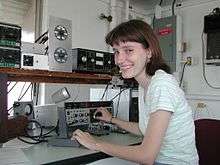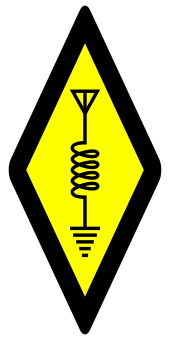Amateur radio operator

An amateur radio operator is someone who uses equipment at an amateur radio station to engage in two-way personal communications with other amateur operators on radio frequencies assigned to the amateur radio service. Amateur radio operators have been granted an amateur radio license by a governmental regulatory authority after passing an examination on applicable regulations, electronics, and radio theory and operation. As a component of their license, amateur radio operators are assigned a call sign that they use to identify themselves during communication. There are about three million amateur radio operators worldwide.[1]
Amateur radio operators are also known as radio amateurs or hams. The term "ham" as a nickname for amateur radio operators originated in a pejorative usage (like "ham actor") by operators in commercial and professional radio communities. The word was subsequently adopted by amateur radio operators.
Demographics
| Country | Number of amateur radio operators |
% population | Year of Report |
Source |
|---|---|---|---|---|
| 1,296,059 | 1.012 | 1999 | [2] | |
| 801,424 | 0.248 | 2016 | [3] | |
| 176,278 | 0.275 | 2006 | [2] | |
| 141,000 | 0.288 | 2000 | [2] | |
| 75,262 | 0.092 | 2007 | [4] | |
| 69,183 | 0.201 | 2011 | [3] | |
| 68,692 | 0.296 | 1999 | [2] | |
| 58,700 | 0.127 | 1999 | [2] | |
| 58,426 | 0.094 | 2000 | [2] | |
| 38,000 | 0.026 | 1993 | [2] | |
| 32,053 | 0.016 | 1997 | [2] | |
| 30,000 | 0.049 | 1993 | [2] | |
| 27,815 | 0.011 | 1997 | [2] | |
| 14,160 | 0.02 | 2013 | [2] | |
| 17,265 | 0.037 | 2000 | [2] | |
| 16,889 | 0.042 | 1999 | [2] | |
| 16,000 | 0.041 | 2000 | [2] | |
| 15,328 | 0.067 | 2000 | [2] | |
| 15,679 | 0.001 | 2000 | [2] | |
| 10,509 | 0.0004 | 2016 | [2] | |
| 8,668 | 0.156 | 2012 | [5] | |
| 6,500 | 0.317 | 2000 | [2] | |
| 6,000 | 0.012 | 1994 | [2] | |
| 5,967 | 0.068 | 2016 | [6] | |
| 5,302 | 0.106 | 2000 | [2] | |
| 5,000 | 0.090 | 2016 | [7] | |
Few governments maintain detailed demographic statistics of their amateur radio operator populations, aside from recording the total number of licensed operators. The majority of amateur radio operators worldwide reside in Japan, the United States, Thailand, South Korea, and the nations of Europe. The top five countries by percentage of the population are Japan, Slovenia, Taiwan, South Korea and Thailand. Only the governments of Yemen and North Korea currently prohibit their citizens from becoming amateur radio operators. In some countries, acquiring an amateur radio license is difficult because of the bureaucratic processes or fees that place access to a license out of reach for most citizens. Most nations permit foreign nationals to earn an amateur radio license, but very few amateur radio operators are licensed in multiple countries.
Gender
In the vast majority of countries, the population of amateur radio operators is predominantly male. In China 12% of amateur radio operators are women,[8] whilst in the United States is it approximately 15%.[9] The Young Ladies Radio League is an international organization of female amateur radio operators.
A male amateur radio operator can be referred to as an OM, an abbreviation used in Morse code telegraphy for "old man", regardless of the operator's age. A female amateur radio operator can be referred to as a YL, from the abbreviation used for "young lady", regardless of the operator's age. XYL was once used by amateur radio operators to refer to an unlicensed woman, usually the wife of a male amateur radio operator; today, the term has come to mean any female spouse of an amateur radio operator, licensed or not. Sometimes the wife of a ham operator is called a YF (wife). Although these codes are derived from English language abbreviations, their use is common among amateur radio operators worldwide. Incidentally, the most common language heard in the HF amateur bands (the bands below 30 MHz that support worldwide communications) is English.
Age
In most countries there is no minimum age requirement to earn an amateur radio license and become an amateur radio operator. Although the number of amateur radio operators in many countries increases from year to year, the average age of amateur radio operators is quite high. In some countries, the average age is over 80 years old, with most amateur radio operators earning their license in their 40s or 50s.
Some national radio societies have responded to this by developing programs specifically to encourage youth participation in amateur radio, such as the American Radio Relay League's Amateur Radio Education and Technology Program.[10] The World Wide Young Contesters organization promotes youth involvement, particularly amongst Europeans, in competitive radio contesting. A strong tie also exists between the amateur radio community and the Scouting movement to introduce radio technology to youth. WOSM's annual Jamboree On The Air is Scouting's largest activity, with a half million Scouts and Guides speaking with each other using amateur radio each October.[11]
Silent Key
Silent key refers to an amateur radio operator who is deceased.[12] The term can be abbreviated 'SK', especially in morse code.[13] The "key" in the term refers to a telegraph key, the instrument that all early amateur radio operators, as well as many contemporary amateur radio operators, have used to send Morse code. The term SK, used in telegraphy to indicate an end of transmission, is therefore also used to refer to any amateur radio operator who is deceased, regardless of whether or not they were known to have used a telegraph key or Morse code in their two-way personal communications.
Gallery
-

An operator running High Speed Telegraphy
-

An operator working HF
-

Amateur Radio station equipped for reception of VLF signals.
-

Shack of F6BLK in September 2008
References
- ↑ Silver, H Ward (23 April 2004). Ham Radio for Dummies. Indianapolis: Wiley Publishing. ISBN 978-0-7645-5987-7. OCLC 55092631.
- 1 2 3 4 5 6 7 8 9 10 11 12 13 14 15 16 17 18 19 20 "Status Summary of Radio Amateurs & Amateur Stations of the World". International Amateur Radio Union (IARU.org). Archived from the original on 28 June 2007. Retrieved 13 July 2007.
- 1 2 "Hamdata Callsign Server". Hamdata.com. Archived from the original on 21 March 2016. Retrieved 26 March 2016.
- ↑ Bundesnetzagentur, cited by "Licencestatistic for DL". DARC.de. Archived from the original on 9 April 2008. Retrieved 18 June 2008.
- ↑ IT & Telestyrelsen Frekvensregister "IT & Telestyrelsen - Frekvensregister". Retrieved 11 January 2012.
- ↑ "Rufzeichenliste österreichischer Amateurfunkstellen" (PDF). Retrieved 4 January 2016.
- ↑ "Mitä radioamatööritoiminta on?". SRAL.fi. Retrieved 6 March 2016.
- ↑ Chinese Radio Sports Association (2004). "The Current Status of Amateur Radio in the Mainland of China". Proceedings of the International Amateur Radio Union's Region 3 Twelfth Regional Conference. Document No. 04/XII/057.
- ↑ Harker, Kenneth E (15 March 2005). "A Study of Amateur Radio Gender Demographics". ARRL.org. Archived from the original on 23 February 2007. Retrieved 13 July 2007.
- ↑ "The ARRL Amateur Radio Education & Technology Program". ARRL.org. Archived from the original on 25 June 2007. Retrieved 13 July 2007.
- ↑ "All about JOTA". Scout.org. September 2006. Archived from the original on 9 May 2008. Retrieved 30 April 2008.
- ↑ ARRL "Silent Key" submission guidelines. Retrieved 10 August 2007
- ↑ List of morse code abbreviations. Retrieved 10 August 2007
